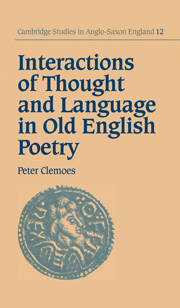Book contents
- Frontmatter
- Contents
- Illustrations
- Preface
- Abbreviations
- PART I The poetry of an aristocratic warrior society
- 1 The chronological implications of the bond between kingship in Beowulf and kingship in practice
- 2 Society's ancient conceptions of active being and narrative living
- 3 Poetry's tradition of symbolic expression
- 4 The language of symbolic expression
- 5 Types of symbolic narrative
- 6 Basic characteristics of symbolic story
- PART II The poetry of a universal religion
- Works cited
- Index I Quotations of two or more ‘lines’ of Old English poetry
- Index II A representative selection of the symbols and word pairs cited in discussion
- Index III General
2 - Society's ancient conceptions of active being and narrative living
Published online by Cambridge University Press: 18 December 2009
- Frontmatter
- Contents
- Illustrations
- Preface
- Abbreviations
- PART I The poetry of an aristocratic warrior society
- 1 The chronological implications of the bond between kingship in Beowulf and kingship in practice
- 2 Society's ancient conceptions of active being and narrative living
- 3 Poetry's tradition of symbolic expression
- 4 The language of symbolic expression
- 5 Types of symbolic narrative
- 6 Basic characteristics of symbolic story
- PART II The poetry of a universal religion
- Works cited
- Index I Quotations of two or more ‘lines’ of Old English poetry
- Index II A representative selection of the symbols and word pairs cited in discussion
- Index III General
Summary
Old English poetry's transmission from its Germanic past of not only society's collective wisdom about itself but also its established perception of both the environment it needed to control and its human resources for doing so was the basis of the Beowulf poet's narrative authority. A monster-and dragon-slayer of his hero's sort was contending with forces in the world at large. Grendel represented a degraded form of human life and the dragon was a threat from outside mankind altogether. The dangers these enemies posed were based not just within society. Beowulf's representativeness of social values was being tested beyond its usual range. It was being exposed to antagonisms involving society's conception of its habitat. The story's dimensions were those of humanity in its total surroundings. A poem of this sort deployed an ancient system of expression which included non-human (or partly human) as well as human active beings.
The Beowulf poet's core vocabulary for the nature of his main protagonists exemplifies both the conceptual principles of this system and its antiquity. Beowulf and Wiglaf, who jointly killed the dragon, and the dragon, which they killed and which killed Beowulf, all possessed the same fighting spirit, ellen (Beowulf 2706b and 2348–9a). It was the ingredient fundamental to the fighting capability of any being, whether human or otherwise. A sword, for example, could perform an ellenweorc, ‘deed of fighting mettle’ (1457–64). By exercising this power a combatant could kill his enemies (2706b and 2916–19a) and attain the material rewards for doing so (660b–1, 892b–5a and 2535b–6a). It constituted his claim to fame (340–1a, 358a, 827b–8a, 1470b–1a, 1787–9a, 3062b–4a and 3173–4a).
- Type
- Chapter
- Information
- Interactions of Thought and Language in Old English Poetry , pp. 68 - 116Publisher: Cambridge University PressPrint publication year: 1995

